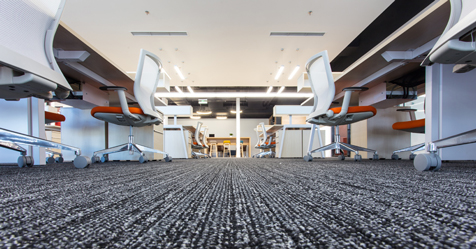The importance of a carpet vacuuming strategy is often overlooked by cleaning professionals. This can be especially true in a larger facility of 10,000 square feet or more, where a vacuum cleaning strategy becomes crucial. The two main reasons for this are time and the health of the carpet.
In terms of time, consider this example: According to ISSA’s 612 Cleaning Times, it takes 17 minutes to clean about 1,000 square feet using an 18-inch, two-motor upright vacuum cleaner. If a facility has 10,000 square feet of carpeting and all areas are vacuumed every night, that’s almost three hours of vacuuming every evening. Reducing this time can allow cleaning workers to perform other cleaning tasks.
As to the health of the carpet, we must always remember that carpet often hides soil, especially dry soil. A strategy that calls for vacuuming based only on appearance may impact not only the health of the facility, but the health of the carpet, as well. Soils can cut carpet fibers, reducing the life expectancy of the entire carpet.
A carpet vacuuming strategy can define how frequently vacuuming is needed in specific areas and, based on an analysis of the facility, what type of vacuum is best suited for the job. Incorporating such a strategy can help save time and also protect the health of the carpet and the facility.
The sections below divide facility areas between those that do not need as much attention and those that do, depending on how much foot traffic and use each area receives. Of course, these guidelines may not apply to all facilities, which is all the more reason to perform your own analysis. Vacuum options are also important to consider.
Areas That Need Less Frequent Vacuuming
Executive areas: Very often cleaning professionals give added vacuuming attention to C-level areas just because that’s where the executives work. But these are invariably the areas that need the least vacuuming. Vacuuming twice per week should be adequate.
Meeting rooms: The carpet in conference and meeting rooms, even if they are used frequently, tends to remain fairly clean. These areas should be spot-checked and thoroughly vacuumed once per week.
Individual office spaces: Although we are moving into an era of open-space floor plans, many facilities still have private offices. Private offices should be vacuumed once or twice per week.
Outlining areas: How does the carpet along the walls and edges of the facilities look? Invariably, it looks brand new. Because of this, outlining areas in work areas, hallways, etc., need infrequent vacuuming.
Areas That Need More Frequent Vacuuming
Transition areas: Transition areas are where hard-surface floors meet carpet. If a hard-surface floor is soiled, dirt from it will likely deposit on the carpet. Transition areas need frequent vacuuming.
Open workspaces/central activity areas: Open workspaces may need a considerable amount of vacuuming, likely at every visit. The more people working in these areas, the more vacuuming attention they will need.
Funnel areas: Funnel areas are those where foot traffic may converge, taking people from one area to another, such as right outside an elevator. These areas will likely need vacuuming every night. This could include the interior of the elevator, as well, if it is carpeted.
Pathways: A carpeted pathway is usually considered a corridor or hallway, but it can also be a walkway within an open workspace area. Pathways need frequent vacuuming.
Water fountains: Carpeted areas around water fountains tend to become soiled very quickly. These areas may need vacuuming two or three times per week.
Vacuum Cleaner Selection
A critical part of an effective carpet vacuuming strategy is vacuum cleaner selection. In this case, selection does not refer to brands, but to types of vacuum cleaners. The following should offer some insight into which types of vacuum cleaners may work best and where.
Wide-area vacuum cleaners: These are often overlooked in vacuum cleaner selection. A 30-inch, wide-area vacuum cleaner can clean up to 10,000 square feet in an hour, which is far faster than vacuuming with other types of machines. They work well on wide or long walkways as well as large open spaces.
Upright vacuums: An upright vacuum is recommended in office areas that are moderately congested and where there is some open space around desks, furniture, and other obstacles. Be sure to select the right-sized upright. Most uprights have a cleaning path of 13 to 19 inches.
Backpack vacuums: Now that the harnesses on some backpack vacuums have become more comfortable, cleaning professionals are using them in all types of carpeted areas, but they are particularly helpful in more congested and transition areas. This is because the backpack vacuum can be used to clean both carpets and hard surface floors.
Canister vacuums: Finally, don’t forget about canisters. Canister vacuums are becoming more and more popular because they are so versatile. Canisters are especially useful for day cleaning because some are so quiet, they can be used where people are working with little disturbance.


